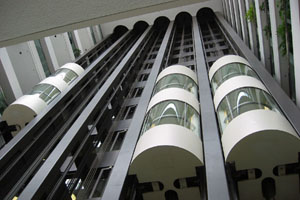Elevators have advanced mechanical systems to keep the weight of the cabin and load under control. In addition to this, there is a need for security systems for proper operation of the elevator and control systems for convenient operation. There are two types of elevators which are widely used in workplaces and residences: hydraulic lifts and rope lifts.
Hydraulic Lift In the systems, the cabinet is removed by means of a piston guided by the liquid formed in the cylinder. This cylinder is connected to the liquid pumping system and is generally used as liquid or other non-compressible liquids. The hydraulic lift system has three main sections: a tank in which the liquid is placed, a pump powered by the electric motor and a valve located between the cylinder and the fluid reservoir.
The fluid is pushed from the reservoir to the cylinder by the pump. When the valve is opened, the fluid under pressure returns to the tank. When the valve is closed, the fluid under pressure enters the cylinder and is collected there. In this case, the piston is pushed up and the elevator car rises. When the cabinet reaches the desired floor, the control system sends signals to the electric motor to shut down the pump. To lower the cab, this time the control system sends signals to the valve in that direction. The valve opens and the fluid accumulated in the cylinder returns to the tank. In this way, the cabin begins to descend.
Elevator Maintenance and Operation Regulations have been enacted in order to ensure that the elevators operate without causing danger to people and property. This regulation sets out the rules to be followed for the operation, maintenance, periodic inspections, warranty conditions and after-sales services of the elevators.
In addition, the Regulation on Health and Safety Conditions in the Use of Work Equipment describes the conditions to be complied with in terms of health and safety during the use of elevators. Accordingly, man and load-bearing elevators should be inspected at least once a year if no other period is specified in the relevant standards.
Annex of the Regulation entitled Maintenance, Repair and Periodic Controls (Annex 3), elevators, Lifting and forwarding tools group. Inspections and inspections must be carried out by mechanical engineers, machine technicians or high technicians. Persons who are authorized in the electrical parts of the elevators should also be involved in these control works.
The following basic standards are also taken into account:
- TS EN 81-3 + A1 Lifts - Safety regulations for construction and assembly - Part 3: Electrical and hydraulic service lifts
- TS EN 13015 + A1 Maintenance of elevators and escalators - Rules for maintenance instructions
- TS ISO 9386-1 Power-driven lifting platforms for handicapped people - Safety, dimensions and rules for functional operation - Part 1: Vertical lifting platforms
- TS ISO 9386-2 Power-driven lifting platforms for mobility-impaired people - Safety, dimensions and functional requirements - Part 2: Power-driven stair lift for moving users, standing users and wheelchair users in a tilted plane
TÜRCERT certification body is also testing and inspection services also gives. TÜRCERT, with its experienced managers and employees, is ready to provide all necessary services to organizations in every sector, if you want to get more information about hydraulic lift periodical inspection or to have these inspections and inspections.

